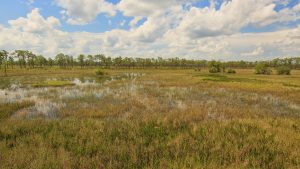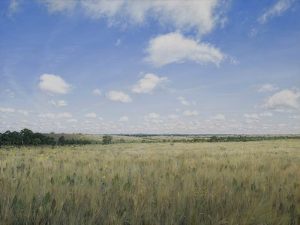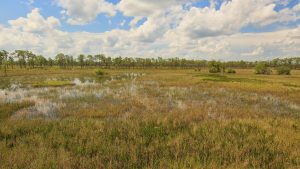Seminar Summary: Clarifying Science Needs for Southeastern Grasslands: The Piedmont, Coastal Plain, and Beyond

On June 18, 2020, Dr. Jennifer Cartwright (USGS Lower Mississippi-Gulf Water Science Center), Dr. Dwayne Estes (Southeastern Grasslands Initiative), and Dr. Rua Mordecai (South Atlantic Conservation Blueprint) presented the third seminar in our SE CASC & South Atlantic Spring/ Summer Science Series, entitled Clarifying Science Needs for Southeastern Grasslands: The Piedmont, Coastal Plain, and Beyond. View a recording of the presentation here.

Image Credit: Philip Juras
Dr. Dwayne Estes began the conversation by presenting an overview of the history of grasslands in the southeast region. Have you ever heard the story about the myth of the squirrel? This is the belief that at the time that Europeans first arrived in America, a squirrel could easily travel from the Atlantic Ocean to the Mississippi River. It is widely assumed that the southeastern region was once abundantly full of forests and resembled the Great Smoky Mountains, but that is not a true depiction of what this vast landscape once looked like. Dr. Estes shared a French map from the year 1720 that illustrates savanna land and pastures were abundant throughout central Tennessee and Kentucky. Northern Alabama and Mississippi were filled with “all level and good ground,” and The Carolinas and northern Florida were once vast, open savannas. We can thank Dr. Reed Noss for this new understanding of these landscapes, as he is credited for having “written the book” about southern grasslands. His book, “Forgotten Grasslands of the South,” was published in 2013 and provides an immense history and description of grasslands in the south. There are many diverse types of landscapes that he introduces – prairies, savannas, balds, glades, barrens, fens, meadows/bogs, marshes, and riverscours. Artist Philip Juras created a beautiful depiction of what the Black Belt Prairie, or what is now Montgomery County, Alabama, would have looked like in the year 1775 – a strong contrast from the dense tree canopy that now fills the county.
Dr. Jennifer Cartwright then connected this history of grasslands to current management objectives, concerns, and emerging threats that grasslands are facing today. She spoke of the importance of Species Status Assessments – biological risk assessments conducted by the US Fish and Wildlife Service, in preserving and restoring these forgotten lands. These assessments have legal and regulatory outcomes and are comprised of several components. Most notably, these assessments inform legal decisions under the US Endangered Species Act and can require that the USFWS perform forecasting or projections for a range of possible future climate conditions for the species in question.
 Often, there is a lack of available science to support that effort, but the SE CASC recently funded a project entitled Clarifying Science Needs for Southeastern Grasslands which has an objective of bringing together grasslands experts from across the southeast to identify and clarify these science needs. This group of experts met for a workshop in January of 2020 and identified the top three risks for southern grasslands as development and urban sprawl, woody encroachment which is related to the alteration of historical fire regimes, and invasive species. The top identified barriers barriers to effective management of these lands include limited funding and limited staff/personnel time. The top research needs identified include grassland mapping and connectivity, the role of prescribed fire, and climate change/changing hydrology (changing soil moisture patterns). These science needs identified during the workshop are being synthesized into a white paper that will be published later this year.
Often, there is a lack of available science to support that effort, but the SE CASC recently funded a project entitled Clarifying Science Needs for Southeastern Grasslands which has an objective of bringing together grasslands experts from across the southeast to identify and clarify these science needs. This group of experts met for a workshop in January of 2020 and identified the top three risks for southern grasslands as development and urban sprawl, woody encroachment which is related to the alteration of historical fire regimes, and invasive species. The top identified barriers barriers to effective management of these lands include limited funding and limited staff/personnel time. The top research needs identified include grassland mapping and connectivity, the role of prescribed fire, and climate change/changing hydrology (changing soil moisture patterns). These science needs identified during the workshop are being synthesized into a white paper that will be published later this year.
The Southeastern Grasslands Initiative is an organization that recognizes these challenges and is making significant strides in conserving grassland landscapes. This group was formed in 2018 and focuses on leadership and the implementation of grasslands conservation, policy and advocacy grants programs, and education & outreach as a means for building capacity for grasslands conservation. SGI aspires to “chart a new course for conservation.” You can learn more about this organization here.
Dr. Rua Mordecai provided details of some regional conservation efforts specifically throughout the Piedmont region. He mentions that the concepts set forth earlier in the presentation by Dr. Estes and Dr. Cartwright are even more exacerbated throughout the Piedmont as this area is under stress by some of the highest growth urban mega regions in the entire south. During the development of a shared plan for conservation action, early testing by the South Atlantic Blueprint showed that the South Atlantic Indictors weren’t as effective for Piedmont prairie plants often because many of these endangered plants are located in areas where woody encroachment keeps getting knocked back by roadsides and power line cuts. This realization provided an opportunity to improve how the Blueprint works and improve the ability to meet conservation goals in the Piedmont Prairies.
The Piedmont Prairie Partnership is a group of non-profit, state, and federal agencies who are committed to working together to restore Piedmont Prairies. The Southeastern Grasslands Initiative, Southeast Conservation Adaptation Strategy, and South Atlantic Landscape Conservation Cooperative are integral members of this partnership. This initiative started with targeted education through informative videos and an effort to build up the prairies as recreation and tourism assets by allowing people to visit these places and by telling the stories of the areas that surround them has proven to be successful. You can learn more about the network of grasslands here and if you know of a prairie that’s publicly accessible but you don’t see it reflected, you can submit your suggestion to be added to the map!
Join us on July 16, 2020 at 10AM ET for the fourth and final presentation in our SE CASC & South Atlantic Spring/Summer Science Series. Dr. John Kupfer will be presenting: Perspectives on Prescribed Fire Management in Longleaf Pine Ecosystems: The Context of Landscape Transformation and Anthropogenic Climate Change. Register for the presentation here.
- Categories:
